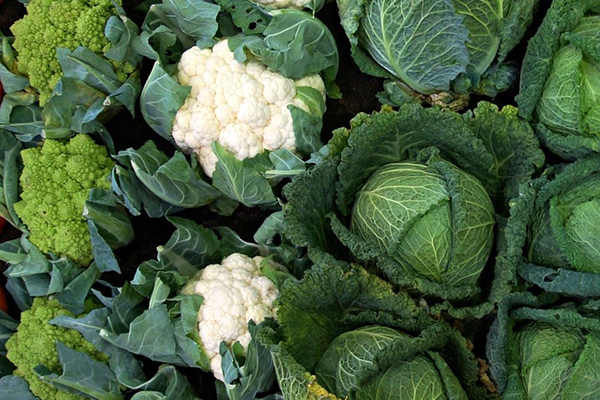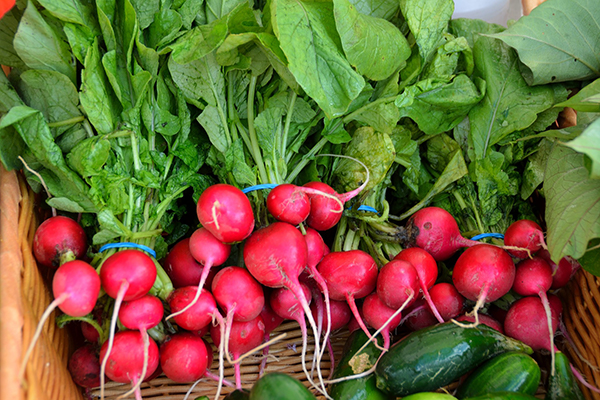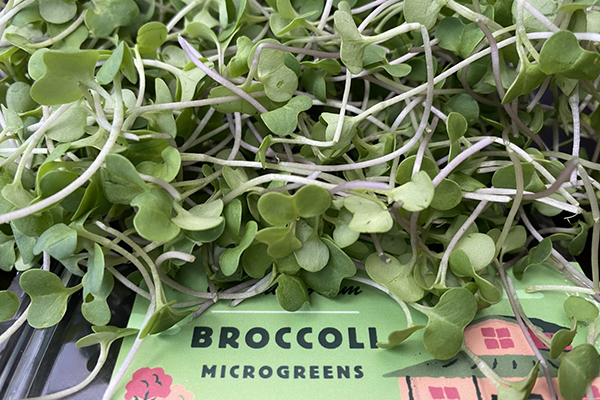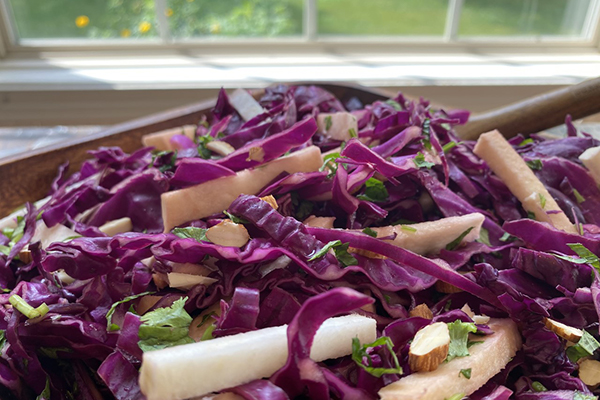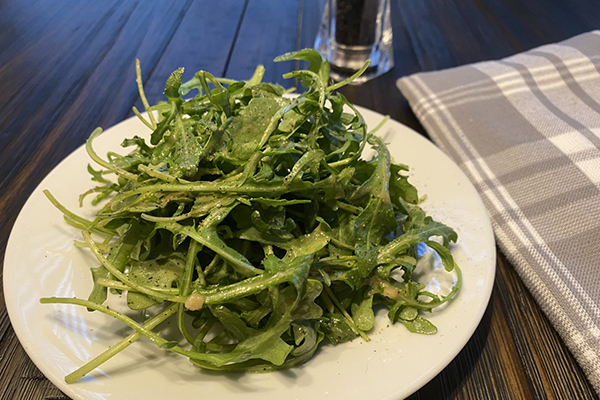Do you have a love/hate relationship with cruciferous vegetables? You love eating them, but your gut hates digesting them? Or you can’t stand the bitter flavor, but you would love to get the health benefits from eating them? Whether it’s your taste buds or your belly that has a crucifer aversion, their potent nutritional benefits make them worthy of another try.
What makes a vegetable cruciferous?
The original Latin definition of crucifer is “one who carries a cross,” and true to their namesake, cruciferous vegetables sport flowers with four petals that resemble a cross. Most edible crucifers belong to the Brassica (mustard) genus, and there are hundreds of them to choose from, some more well-known than others.
Below are some of the most commonly eaten ones in the United States with a few less familiar varieties thrown in to keep things interesting. (Hint: Click on the table below to find links for recipes that use each of them.)
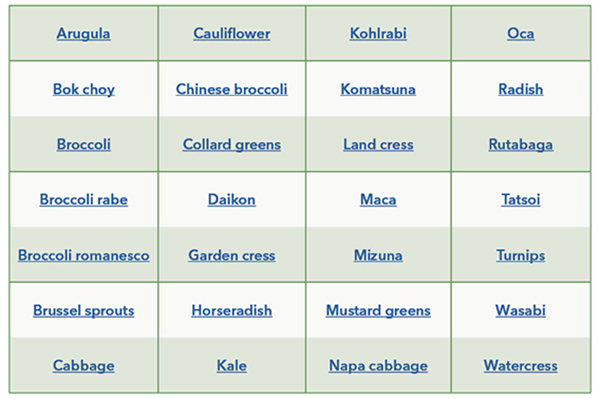
What are the health benefits?
Aside from the significant folate, vitamin K, vitamin C, vitamin A, potassium, calcium and fiber content in many cruciferous vegetables, their real claim to fame is their detoxifying, cardiovascular-supporting and cancer-preventing potential.
Cruciferous veggies are a rich source of sulfur-containing phytochemicals called glucosinolates. Broccoli and broccoli sprouts, in particular, have gotten a lot of attention for their high levels of glucosinalates. These compounds get converted into health-promoting isothiocyanates when you chop and chew them. The isothiocyanates act as antioxidants and have anti-inflammatory properties. They also upregulate the liver’s production of detoxification enzymes to help neutralize toxins and carcinogens (including heavy metals, petro-chemicals, estrogen metabolites and alcohol) and get them ready to be transported out of the body.
Don’t miss out on the health benefits of cruciferous #vegetables! Learn why you should love them and how to grow that love. #saslife Click To TweetWhat are the recommendations?
Nutrient and phytochemical content varies based on vegetable type, where and how it is grown, part of the plant used, preparation method, etc., so eat a variety to cover your bases. Eating cruciferous vegetables in their raw form will provide you with the biggest benefit. Though cooking limits the conversion of the glucosinalates into isothiocyanates, research suggests that gut bacteria help to convert some glucosinalates to isothiocyanates (good news!), and interestingly adding mustard seed/ground mustard to cooked crucifers can help increase the isothiocyanates as well.
There are plenty of other health benefits associated with all crucifers (heated or not), so feel free to eat them cooked, raw or a combination of both. If you are already comfortable with cruciferous vegetables, aim for two servings daily, and make at least one serving raw (think salad, coleslaw or blended into smoothies). If eating these vegetables is a struggle for you, start with less, and read on.
What if you don’t like the taste?
If the bitter flavor of those health-promoting isothiocyanates is overpowering to you, first know that there is a biological reason why you don’t care for the flavor. Whether it’s because you were not exposed to these foods when you were younger so your taste buds haven’t adapted to their pungency, or if you are truly a super taster, there are ways to get your palate to acclimate.
Try these tips to help you warm up to these detoxifying veggies:
- Start by adding small amounts to foods you already like on a regular basis — blended into smoothies or chopped into small pieces and added to soups, pasta sauces, casseroles, etc.
- Be patient with your palate. Every couple weeks you should be able to level up and slowly push the limits on your palate as you get used to the taste. You’ll slowly condition your palate to start enjoying the vegetable. For example, if you’ve been covering your broccoli in cheese for years, you’ve probably conditioned your brain to start liking broccoli. Eventually, if you’d like, decrease the amount of cheese in the dish, and you’ll likely find that you still enjoy it.
- Massage and chop your dark leafy greens, and then rinse them to get rid of some of the bitter compounds.
- Find a different cooking method. Try roasting broccoli, cauliflower and Brussels sprouts.
- Blanch veggies that are particularly bitter, like broccoli rabe, before cooking by submerging it in boiling water for about a minute, and then immediately plunging it into an ice bath to stop the cooking process.
- Balance the bitter by pairing the vegetables with umami (savory flavors), fat, garlic, lemon, salt and/or pepper.
- Avoid overcooking crucifers because this may increase their bitterness by increasing production of sulfur compounds.
- Try a different veggie. Some cruciferous root vegetables, like turnips and rutabagas, still have glucosinolates, but taste nothing like kale.
Check out more strategies to try if you hate vegetables.
What if you have trouble digesting them?
Many cruciferous vegetables contain certain fermentable carbohydrates that are poorly digested and absorbed by some people (referred to as FODMAPS — Fermentable Oligosaccharides, Disaccharides, Monosaccharides and Polyols). When this happens, the bacteria in your large intestine ferment these carbohydrates that are not fully digested, producing gas, often accompanied by bloating and pain, and sometimes diarrhea or constipation. Some crucifers (like cauliflower, Brussels sprouts, broccoli and cabbage) have more of these carbohydrate culprits than others. The insoluble fiber content in vegetables may also contribute to GI distress for some people.
Before giving up on these foods forever, try the suggestions below:
- Start with cooked vegetables which are usually easier to tolerate than raw.
- Try turnips, rutabagas and radishes which are lower in FODMAPs than some other cruciferous veggies.
- Incorporate microgreens or sprouts in soups, salads or sandwiches, on top of fish, blended into a pesto, etc. They are loaded with good phytochemicals and may be easier to digest.
- Start with small servings of harder to handle cruciferous varieties — less than half a cup per day. If and when your body gets used to that, slowly increase your portion.
- Try taking digestive enzymes with meals that contain the culprits.
- If you struggle with gastro-intestinal issues in general, work with your health care provider to rule out other underlying causes of your symptoms.
- A Registered Dietitian Nutritionist can work with you on a safe plan to eliminate or limit potential triggers for a period of time, rebalance and repair the gut and then get you back to a diverse eating plan personalized for you.
Arugula Salad with Garlicky Anchovy Dressing
Recipe adapted from NYT Cooking
Makes 2-4 servings
PRINT RECIPE
Ingredients
1 Tbsp lemon juice (from ½ lemon), plus more if needed
1 garlic clove, minced
2 anchovies, or more to taste
1-2 Tbsp chopped parsley
2 Tbsp extra-virgin olive oil
5 oz package baby arugula
Ground black pepper, to taste
Flaky sea salt, to taste
Directions
- Combine lemon juice and garlic in a blender.
- Let sit for 2 minutes, then add anchovies and parsley, and blend to combine.
- With blender running, drizzle in oil until emulsified.
- Taste and add more lemon or a bit of salt if needed.
- Toss together arugula and just enough of the dressing to coat the leaves in a large bowl (you may not need all of it).
- Sprinkle with pepper and flaky sea salt if desired, and serve immediately.
Note: You can adjust the dressing’s pungency by adding more or fewer anchovies. The dressing will keep for a few days in the fridge, but the oil will solidify, so remember to take it out at least an hour before serving, and shake it really well.
